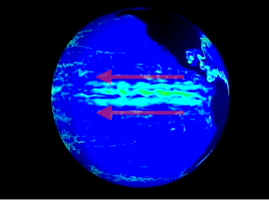Teachers' Domain - Digital Media for the Classroom and Professional Development
User: Preview

Source: ThinkTV
Ocean currents are a vital piece of the puzzle that explains how the global climate system works. Without them, there would be no way for Earth's oceans to distribute their incredibly large supplies of heat energy around the world, warming climates in some regions while cooling them in others.
In the oceans, a current refers to the motion of water. There are different kinds of currents moving in paths in different parts of the world. Tidal currents move with the motion of high and low tides, flooding toward land and then ebbing away in response to the gravitational pull of the Moon. Coastal currents, such as the California Current described in the video, move in response to dominant, prevailing local winds. Open-ocean surface currents, meanwhile, are currents put in motion by global wind patterns, such as the tropical and sub-tropical winds that blow from the east (trade winds) or the west-to-east-flowing winds at mid-latitudes (the westerlies).
Surface ocean currents are also driven by an effect caused by Earth's rotation on its axis known as the Coriolis effect. The rotation of Earth acts to turn or deflect prevailing winds clockwise in the Northern Hemisphere and counterclockwise in the Southern Hemisphere, which deflects the surface currents.
When the winds that drive surface currents strengthen or weaken, they can cause profound changes in surface ocean currents. This is the case with the phenomenon known as El Niño, in which currents off the coast of South America slow down in response to a weakening of the easterly trade winds.
In addition to surface ocean currents, there are also currents deep below the surface. Sub surface currents flow thousands of meters below the surface, and are driven by another mechanism: changes in the density of ocean water as it travels between the warm equator and the chilly polar regions of Earth. Warm water, as it nears the poles, becomes cooler and denser and sinks. The water, now a sub surface current, moves in predictable patterns throughout the deep ocean, slowly mixing with less dense water.
Energy transfer is an essential function played by ocean currents. By transferring heat energy around the globe, ocean currents shape both local weather conditions and global climate. For example, warm ocean currents create the conditions that spawn tropical cyclones and hurricanes—local severe weather conditions. On a larger scale, warm ocean currents such as the Gulf Stream warm entire continents, and help create and sustain global climate conditions.
Here are suggested ways to engage students with this video and with activities related to this topic..
 Loading Standards
Loading Standards